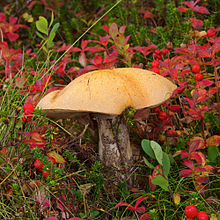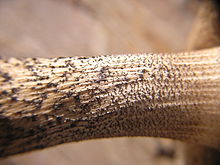Leccinum versipelle
| Leccinum versipelle | |
|---|---|

| |
| Scientific classification | |
| Domain: | Eukaryota |
| Kingdom: | Fungi |
| Division: | Basidiomycota |
| Class: | Agaricomycetes |
| Order: | Boletales |
| Family: | Boletaceae |
| Genus: | Leccinum |
| Species: | L. versipelle
|
| Binomial name | |
| Leccinum versipelle | |
| Synonyms | |
| |
Leccinum versipelle, also known as Boletus testaceoscaber, dark-stalked bolete, or orange birch bolete, is a common species of mushroom that may be edible when given the right preparation. It is found below birches from July through to November, and turns black when cooked.
Taxonomy
Leccinum is a genus of fungi in the family Boletaceae. It was the name given first to a series of fungi within the genus Boletus, then erected as a new genus last century. Their main distinguishing feature is the small, rigid projections (scabers) that give a rough texture to their stalks. The genus name was coined from the Italian Leccino, for a type of rough-stemmed bolete.

Description

The cap is broadly convex, and be buff to yellow-orange or ochre, bright red-brown or brick red. It is felty and grows up to 20 cm (8 in) in diameter. The flesh is white to pink, turning green-blue or grey, then black when cut, particularly in the stipe. Tubes are grey-brown, staining as flesh. The spores are brown, or smokey to blackish-brown. The stipe is firm, long and slender, white and covered with small black scales. Stalks are up to 20 cm tall by 3.5 cm wide, whitish, and with many raised, black dots. Spore print is yellow-brown to olive.
Distribution and habitat
Leccinum versipelle fruits on the ground in mixed woods.[1]
Edibility
Leccinum versipelle is mildly toxic (causing nausea and vomiting) unless given proper heat treatment: frying or boiling for 15–20 minutes is considered necessary. It is commonly harvested for food in Finland,[2] Latvia, Lithuania, Estonia, Belarus, southeast Alaska and Russia.
Text is available under the CC BY-SA 4.0 license; additional terms may apply.
Images, videos and audio are available under their respective licenses.
